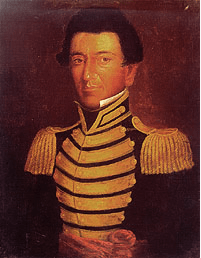Juan Nepomuceno Seguin was born on October 27, 1806 in San Antonio, Texas. His ancestors were founding members of San Antonio and had prominent roles in the beginnings of Texas’ settlement. Seguin’s great-great grandfather, Pedro Ocon y Trillo, served as alderman in the town council during the 1760s. Santiago Seguin, Juan’s grandfather began the ranching tradition in the Seguin family and became one of San Antonio’s principle cattle exporters at the end of the 1770s. Erasmo Seguin, Juan Seguin’s father, was a part of the counterrevolt during the Mexican War for Independence in 1810. From the beginning, the Seguin family was invested in the well-being of the San Antonio community and the Texas settlement. Juan Seguin, himself, became an influential Tejano figure during the Texas Revolution; however, despite a long history of dedication to the well-being of the Texas settlement, he was faced with false accusations despite his endless display of patriotism and efforts that supported the Texian cause for independence. He was a military captain, in charge of his own command primarily made up of other Tejano soldiers.1 He was a politician receiving the titles such as alderman in 1828, alcade in 1833, then becoming the first Tejano to serve in the Republic of Texas Senate in 1837.2 Most importantly, he was a Tejano achieving these great feats in an Anglo-dominated Texas during the nineteenth century. These accomplishments put him under intense scrutiny. Because of the scrutiny Seguin faced, it is important to remember his legacy as a Tejano hero who made many sacrifices for the health of the Texas settlement. One should read sources from either his Mexican or Anglo contemporaries with caution due to their negative biases towards Tejanos. There were many racial tensions between the Tejanos (Mexicans residing in Texas), Mexicans, and Texians (Anglo settlers in Texas) during the time of the Texas revolution. Juan Seguin, with his numerous accomplishments as a Tejano during the nineteenth century, faced these racial tensions from both the Mexicans and Texians primarily due to his position of power, often with the intent to slander his name and image.

To understand why these racial tensions were so prominent, it is important to understand that Tejano was not a word that existed in the nineteenth century. To the Mexicans and Texians, Juan Seguin was still a Mexican. To the Mexicans, Seguin was a traitor to his country, and to the Texians, despite his continuous display of patriotism, he was still a Mexican and should be looked at suspiciously. Seguin knew of these views he was faced with on both sides, as he stated, “The rumor, that I was a traitor, was seized with avidity; by my enemies in San Antonio. Some envied my position, as held by a Mexican; others found in me an obstacle to the accomplishment of their villainous plans.”3 Having a Mexican in such a high-ranking position made people on both sides uneasy—for the Mexicans, they did not want a traitor in power and for the Texians, they did not want someone with ancestral ties to the enemy nation in such power.
From the Mexican side of hostilities, Seguin knew of rumors coming from Mexican sources. In Seguin’s memoir, he tells of a time in which Chevallie, a Texian revolutionary escaped from imprisonment by the Mexicans, told Seguin about some of the rumors he heard while in captivity.
In combination with the Mexican’s attempt to tarnish Seguin’s reputation, the Texians were trying to mar his image as they did not want a Mexican to hold such a great amount of power. Among the rumors of his disloyalty to Texas, Seguin felt threatened and decided to leave Texas and seek refuge in Mexico, where he thought he could retire among his family in Saltillo. Seguin states, “Chevallie told me that Vasquez [of the Mexican army] and his officers stated that I was on the side of the Mexicans.”4 Another Mexican soldier only known as Sanchez, showed Chevallie a letter claiming that Seguin wrote it, while stating, “Seguin is with us.”4 The goal of this was to convince the Texians that while Seguin seemed to be patriotic to the revolutionary cause, he was secretly working with the Mexicans to go against the Texians’ cause at the same time.
Matters being in this state, I saw that it was necessary to take some step which would place me in security and save my family from constant wretchedness. I had to leave Texas, abandon all for which I had fought and spent my fortune, to become a wanderer. The ingratitude of those who had assumed onto themselves the right of convicting me, their credulity in declaring me a traitor on the basis of mere rumors, the necessity to defend myself for the loyal patriotism with which I had always served Texas, wounded me deeply.6
However, once in Mexico, interesting events took place with what seemed to be another attempt from Mexico to slander Seguin’s name. While Seguin wanted to live in Saltillo where he could be close to his relatives, Santa Anna instead wanted him to go to Mexico City.7 However, there was an alternate, more devious plan that Santa Anna devised. Santa Anna decided to allow Seguin to live in Saltillo under the condition that Seguin join the Mexican military and attack Texas citizens.8 This would have shown the Texians that Seguin might have been on the Mexican’s side all along just as the rumors had claimed, or this could have demonstrated, in general, that Tejanos were vulnerable to switching sides. After this event, Texas Ranger Ben McCulloch called Seguin a traitor and compared him to Benedict Arnold.9 From the beginning, the Mexicans wanted to ruin Seguin’s reputation among the Anglos, and with the requirement to make him serve in the Mexican army, it solidified their plan.

Seguin’s reputation was so tarnished, that he published his memoir in 1858 to explain his side of the story in hopes that people would listen and show empathy towards him. Seguin returned to San Antonio after the Mexican-American War ended in 1848 and lived in Texas until 1867, until racial tensions caused him to move to Mexico for the final time, where he lived out the rest of his life until August 27, 1890. When remembering Juan Seguin and other Tejanos in powerful positions, it is important to be aware that many sources are biased due to the racial tensions present during the time. Despite the label he received by his Mexican and Anglo counterparts as a traitor, today Juan Seguin can be labeled as a Texas hero due to his unyielding loyalty to the Texas settlement.
- Jesus F. de la Teja, A Revolution Remembered: The Memoirs and Selected Correspondence of Juan N. Seguín (Texas State Historical Association, 2002), 20. ↵
- Encyclopaedia Britannica, 2016, s.v. “Juan Seguin: Tejano Revolutionary and Politician.” ↵
- Juan N Seguin, as cited in de la Teja, A Revolution Remembered, 101. ↵
- Juan N. Seguin, as cited in de la Teja, A Revolution Remembered, 94. ↵
- Juan N. Seguin, as cited in de la Teja, A Revolution Remembered, 94. ↵
- Juan N. Seguin, as cited in de la Teja, A Revolution Remembered, 96. ↵
- Juan N. Seguin, as cited in de la Teja, A Revolution Remembered, 97. ↵
- Juan N. Seguin, as cited in de la Teja, A Revolution Remembered, 97. ↵
- Ben McCulloch to William W.S. Bliss, June 23, 1846, Ben and Henry Eustace McCulloch Family Papers, 1798-1961, Dolph Briscoe Center for American History, The University of Texas at Austin. ↵



35 comments
Antoinette Johnson
Seguin faced many challenges from Mexicans and Texians due to the fact that he was in a high position of power. Both groups wanted to slander his name for various reasons. Even though he was so loyal it did not matter. Seguin’s made goal and concern was for the well-being of San Antonio, TX. The Mexicans saw him as a traitor and the Texians saw him as racially inferior. It did not matter how hard that Seguin tried to prove that he was looking out for the benefit of Texas.
Tessa Bodukoglu
this article was very informative and had a lot of very good information. The lay out of the article was very easy to read and understand for the most part. The fact that they thought he was a traitor is what confuses me. He was a Mexican man in a position of power and his own people didn’t like him and because he was a Mexican, the texians didn’t like him either. For the most pat it seemed like no one liked him with is a very bad situation to be in especially back in his day.
Jocelyn Moreno
Wow. Being in Seguin’s shoes would’ve been difficult for me. They made him choose a side when he just wanted peace between both. It’s so sad how they drove him away from San Antonio twice in hopes of redemption with the people. This article was very informative, I never knew about Seguin before reading this article.
Thomas Fraire
I can’t accept the sum of separation Seguin endured. Truly Texans and Mexicans had to be so cruel. I truly delighted in the article. The sum of portrayal put into the suffrage of Seguin was well-done, counting the illustrative of how it was done so. I truly thought you did a great with this article. I enjoyed it.
Suvesh Vasal
Wow, this article was so informative and interesting. Being from Dallas and not San Antonio has made something very clear to me: San Antonio has a rich and extensive heritage and culture that cannot be matched by any other major city in Texas. I am constantly reading articles on this website that continue to prove that and continue to teach me things I didn’t know about prior to reading the article. Great article.
Maria Esquivel
After everything Juan Seguin did for Texas it is disappointing how neither side acknowledged the good he did. I really like how you provided the differences between the Mexicans and the Texians and the way both sides perceived him. I see Seguin as a figure who tried to do good for both sides even after both sides saw him as a bad person. In conclusion, I find it important that people continue to learn about the important things Seguin did for Texas. Great Article!
Carlos Vazquez
The early history of San Antonio is super interesting. This was the first major city people passed through on their way from Mexico and it was the last city they saw on their way out of Texas. The racial battle between Mexicans and Texans sadly resulted in the suffering of people like Juan Seguin. This article is very well written and informative and it allows the reader to see how life was in Texas during the 19th century.
Manuel Aguilera
Considering that I grew up around Texas culture and participated in many events concerning the embracement of Texas culture I am surprised to have never heard of such a man. I also liked how you put light on the racial tensions that were developing at the time. The paper also seems very well researched and give good background.
Joel Gracia
It was fascinating to read an article so closely related to the place that I have lived my whole life. I knew our city had rich history, and I enjoyed uncovering one of the countless stories that supports that. It is terrible that Seguin, and probably many others in his same unfortunate position, could not find their place in society in that time due to their mixed roots. I am glad that, even though it is two centuries later, Seguin is getting the recognition he deserves.
Ashley Tumlinson
You did an excellent job at describing the battle people face to this day – this being that you cannot please everyone no matter what you do. It is so sad that he suffered that much because of his accomplishment. This is definitely an important part of Texas history, which I think gets lost in our course study as we further our education.